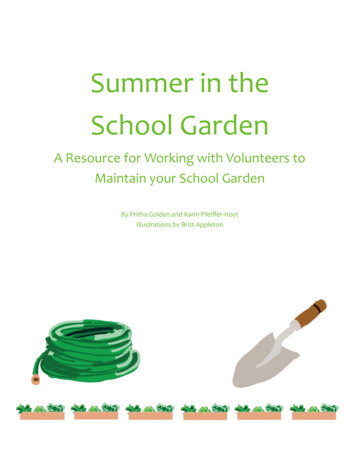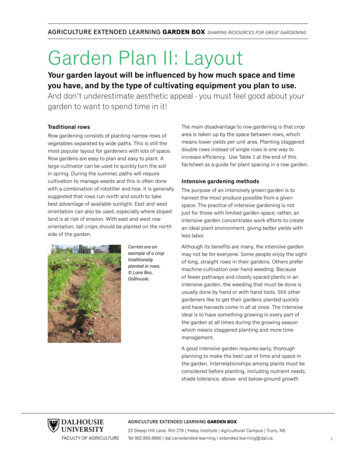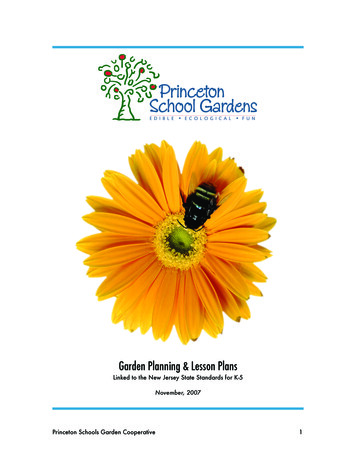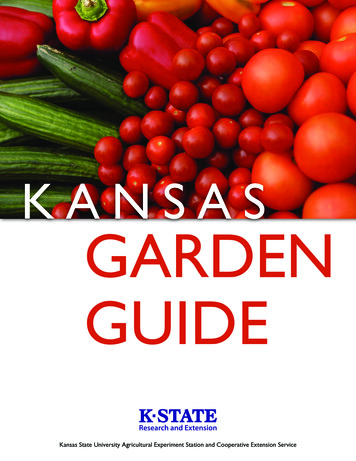
Transcription
Summer in theSchool GardenA Resource for Working with Volunteers toMaintain your School GardenBy Pritha Golden and Karin Pfeiffer-HoytIllustrations by Britt Appleton
2
Intro & AcknowledgmentsWhat is this?This is a resource designed to help school garden coordinators effectively maintain their schoolgardens during the summer. Success during the summer starts by building strong relationships withvolunteers during the school year, so many of our recommendations are applicable throughout the yearand focus on how to best work with volunteers. Many school garden coordinators in the Portland areagenerously gave their time to discuss the successes and challenges that they have faced in their gardensduring the summertime.We developed this document based on the resources that interviewees shared with us and theneeds that they expressed. Our goal is to share tips and techniques that school garden coordinators use tosuccessfully navigate the ins and outs of maintenance in the summer. Many coordinators put in unpaidhours, are strapped for time, and are really working from the heart to make things happen. For this reason,we have created planning and record keeping forms and templates that are customized and ready for useby school garden coordinators. Additionally, we have provided signs which can be printed, laminated, andposted in the garden to help guide students and volunteers in the right direction.We know that there is not a one-size-fits-all solution for school gardens, but we hope that thesetips, templates, and signs are useful and that you are able to customize them to suit your needs. Good luckin your garden!Who are we?The co-authors of this resource are Pritha Golden and Karin Pfeiffer-Hoyt. We are currently servingour 2011-2012 term as AmeriCorps members through the Confluence Environmental Center in the PortlandMetro region. Summer is the most abundant time in gardens, yet it is also the most challenging for schoolsas they are not in session. Inspired to address the need for support at school gardens in the summer, wechose to create this document as our AmeriCorps Change Agent Project. Britt Appleton, a Portland-basedartist, generously donated her time to make all of the illustrations and signs for this document.Thank you!We greatly appreciate and would like to thank the following people: Caitlin Blethen, Julia Gray,Sarah Canterberry, Sarah Sullivan, Kathy Garris, Amanda Hart, Ashley Coltin, Abbie Rankin,and Julie Baasch for taking the time to share their experiences, knowledge, and inputwith us. We also thank the Confluence Environmental Center staff for their support.3
Table of ContentsPart 1: Helpful TipsVolunteers are Worth their Weight in Compost 6Effective strategies for recruiting, coordinating, and engaging your volunteers.Includes tips on how to communicate clearly with volunteers as well as how to havesuccessful work parties and events.Summer Maintenance Models 8Examples of how other coordinators have maintained their gardens in thesummer. Mix and match to develop a plan that works best for you!Maintenance Nuts & Bolts 11Helpful tips from other school gardeners that range from how to weed your gardento vandalism prevention.Part 2: Templates to Use for Success in Your GardenSchool Garden Coordinator Checklist 14Consider this your master list of things to consider when planning for your summerprogram. It includes everything from developing a vision to where tools are stored.Work Party Checklist 16This checklist will help you get everything in line to have a great work party.Maintenance Plan 17This month-by-month template helps you think through the who, what, how, andwhen of tasks to complete in the garden over the course of the year.Sample Maintenance Plan 25This is Abernathy Elementary Schools’ maintenance plan.Volunteer Interest Form 29This form is specifically tailored for school garden volunteers. Have folks fill outthe form and you will have a ton of helpful information about your volunteers on file.Formulario de interés de voluntarios 30The Spanish version of the Volunteer Interest Form.4
Table of Contents (Cont.)Volunteer Maintenance Log (bilingual) 31Have your volunteers fill out this log to keep track of how many hours theyspend maintaining the garden as well as which projects they have completed.Work Party Sign-In Sheet and Waiver 33Just like it sounds. This is a very important tool for gathering contact info fromoccasional volunteers who may become regulars in the future.Planting Date Tracking Sheet 35This sheet helps you track when you planted your veggies, what worked well, andwhat could improve. These records are very helpful for future planning.School Garden Harvest Log (bilingual) 36Tracking your summer harvest is a great way to celebrate success in the gardenand to measure progress for grants and program promotion.Part 3: Signs - Guide Volunteers and Kids with Visual AidsCommon Weeds 37This awesome sign shows common weeds you will find in your garden.Use it as a tool with volunteers and an education piece with students!Water Shut-Off ReminderHere is a helpful reminder to shut the water off.Harvesting 38These green, yellow, and red lights will help folks know when a bed needs to bepicked, is just for sampling, or is off limits.Compost, Weeds and Waste 39Never underestimate the importance of having a place to put yourwonderful waste. These signs designate areas for different materialsand show when your compost bin is not accepting new waste.Farewell and Garden Care 40A thank you to the volunteers and a reminder to take care of the gardenappropriately.5
Volunteers are Worth TheirWeight in CompostRecruitment Be visible within the school community: get to know school families and community members. Build relationships and people will want to get involved. Identify the movers-and-shakers who support your program and ask them to help recruit volunteers. Table at PTA meetings and at Kindergarten Roundup. Advertise in the school newsletter and through email lists. Network with teachers; ask them to recommend parents who they think would be interested. Invite volunteers personally and always follow up by phone or email. Reach out to potential volunteers who may have language and/or cultural barriers. A great way to connectwith these families is through the Parent Engagement Coordinator or other bilingual staff members at yourschool.Coordination & communication Find out what days/times work best for your volunteers and schedule accordingly. Consider the volunteers’ preferred mode of communication (in person, phone, email, google calendar,facebook, etc.). Adapt your communication style to include people without email or computer access. Orientation and training are invaluable! Encourage volunteers to ask you questions. Let volunteers know what your summer availability is and how to best contact you. Remind volunteers to bring any problems, questions, or concerns to your attention. Lay out expectations (both yours and theirs) from the beginning in terms of commitmentlevel and garden ground rules.6
Volunteers are Worth TheirWeight in Compost (Cont.)Engagement The more ownership a volunteer has, the more engaged and committed he/she will be. Include volunteers in the planning and decision-making process as much as possible. Work within your volunteers’ level of commitment and interest: If you have volunteers with specific areas of interest and/or expertise, let them take the lead by starting a new bedsuch as “The Herb Garden” or implement the Adopt-A-Bed model, for example. Create opportunities for casual and one-time participation (i.e. work parties, open hours, harvest events).Follow up and appreciation Check in with volunteers at the end of their work period (either one-on-one or as a group). Ask: What went well? Is there anything they would like to see done differently next time? Did they have everythingthey needed? Did they have fun? For increased volunteer engagement and retention, follow up with volunteers who attend work parties toencourage them to become regular volunteers. Personally invite back regular volunteers from one year to the next. Show appreciation for your volunteers so they keep coming back! Build it into your program, in everythingfrom thanking volunteers at the end of work parties to giving awards or certificates at an appreciation eventat the end of the season.School District policies on volunteers Check with school administrators about your school district’s policies onvolunteers (including liability waivers). The Portland Public School District, forexample, requires that “volunteers who may have potential for direct,unsupervised contact with students must be screened for a criminalbackground.” ices/1106.htm)7
Summer MaintenanceAll of the following methods can be combined or altered to suit your circumstances. All modelsrequire a willingness on behalf of the coordinator to step in and work independently when necessaryas well as the flexibility to support volunteers’ participation in the garden. As a coordinator, it isimportant to consider your availability and needs when developing your maintenance plan. Alsoconsider the interests and commitment level of volunteers, as well as any barriers to participationthey may face.For success in the summer, it is important that you develop strong relationships with volunteersduring the school year. Schedule work parties and drop-in hours before the summer starts. Decidehow you would like people to help so that you can invite volunteers face-to-face while school is still insession.Host garden drop-in hours Have a set weekly schedule when volunteers can access the garden and the tools Drop-in hours can be hosted by a coordinator or be unsupervisedThis model may work well with volunteer supervision if.- You can accommodate or prefer a consistent schedule- You are free during hours when volunteers are available- Volunteers may be new to the garden- Volunteers may need supervisionThis model may work without volunteer supervision if.- You are not available when volunteers are available- You are flexible with mistakes made in the garden- Volunteers enjoy working in the garden either independently, withtheir family or with other families- Volunteers are dedicated and very experienced working in thegarden8
More Maintenance ModelsWork parties and flexible volunteer help Host monthly work parties to finish the bigger, more labor intensive jobs Call groups of dedicated volunteers as needed to help with smaller, more skilled tasksThis model may work well if.- You have the support and supplies to host a monthly work party- Apart from work parties, you enjoy or need flexibility in your schedule- Volunteers enjoy flexibility and are often willing to assist when called in as needed- Volunteers may be new to the garden and need supervisionKids summer programming to cover the basics Use kids’ summer programs to keep the garden weeded and planted Organize volunteer assistance for watering and possible additional maintenanceThis model may work well if.- Your school has a summer program- Students use the garden frequently and are old enough to do weeding and planting- You and/ or volunteers are able to water the garden and finish projects that kids startWeek-by-week maintenance Volunteers sign up for a week of watering/ maintenance/ harvest during the summer Phone calls are needed reminders—consider a volunteer phone treeThis model may work well if.- You regularly check in on garden status and are available for backup- You have the capacity to train volunteers on how to work in the garden-Volunteers are experienced, dedicated and can commit to a set schedule9
Even More Maintenance ModelsDedicated watering volunteer(s) Sometimes neighbors are willing to take on frequent or even full watering responsibilityThis model may work well if.- You are available for back-up any time a volunteer is not available to water- Volunteers are experienced or well trained to water in the garden- Volunteers live walking distance from the gardenAdopt-a-bed Have volunteers sign up to care for and harvest from a garden bed for the summerThis model may work well if.- You have limited availability to assist in the summer- You are willing to accept if some beds are neglected or if plants die- Volunteers enjoy ownership and are experienced gardeners or are mentored- The garden, tools, and watering system are accessible by combination locksLead volunteers take responsibility for maintenance Several volunteers each take the lead in maintaining a different part of the garden Lead volunteers check regularly to asses garden maintenance needs Lead volunteers coordinate other volunteers and host work parties as necessaryThis model may work well if.- You are highly experienced with gardening and volunteer coordination- Lead volunteers are very experienced with gardening and volunteer coordination- Your program is mature in its development10
Maintenance Nuts & BoltsWateringIf you do not have an irrigation system, this is going to be one of the more time consumingand time sensitive tasks in your garden during the summer. Taking time up front to makeyour system as user friendly as possible will save you and your volunteers lots of time andfrustration in the long run. Drip irrigation systems will greatly reduce your work in the garden — keep your eyes openfor volunteers with irrigation skills as well as funding opportunities for your system. Develop a watering method so volunteers have a step-by-step process to follow. The best volunteers for watering often live as close as possible to the garden—startknocking on doors! Set a sprinkler on in one part of the garden while hand watering in another to save time. Knowing when not to water is as important as knowing when to water. Encourage droughtresistance in plants by irrigating more deeply and less frequently. Take tips from an expert!Weeding To encourage a job well done, develop a basic weeding method to use in your garden. Provide an explanation of why this technique works well to serve your garden—the “why”will help newbies learn and will help experienced folks understand what you are looking for. Never assume someone knows the difference between a weed and vegetable. Alwaysdemo which plants you would like to be removed and how. Expect that mistakes are part of the job and never forget that every volunteer has goodintentions!Weeding Note:Save yourself tons of time by removing weeds when they are only 2-3weeks old. At this point, scraping just below the surface of the soil witha sharp weeding tool will cut and uproot very small weeds, (even thoseyou can’t see yet) eliminating the need for “pulling weeds.” Leaveweeds on the surface and they will decompose. Great tools for this jobare the hori hori and the stirrup hoe.11Irrigation Note:Drip systems savewater by slowly releasing water directlywhere it is needed, atthe roots. By watering only garden beds,you will reduce yourwater usage and saveyourself time weeding pathways.Timers are relativelyinexpensive and willallow you to waterthe garden with theflip of a switch or byprogramming an automatic system.Once you have anirrigation system on atimer, most of thework is done for youexcept for routinesystem maintenance .
Maintenance Nuts & Bolts (Cont.)Harvesting Some folks are hesitant to eat veggies from the garden, while others may unknowingly helpthemselves to the last of your carrot crop. To encourage volunteers both to feel comfortablesharing the harvest and also to leave some for others, they must know how much they canharvest certain plants and why. If certain crops are off limits, give clear explanations of what they are being saved for. Use signs to designate which beds can be harvested from and which beds cannot (see signs!). Any fruit or flower will produce much more if harvested more frequently – these are goodcandidates for “help yourself” plants. If you have a scale, don’t forget to track your pounds of harvest and where it is going. If you have extra produce, find a weekly food donation outlet. This makes a great volunteer job.Locks and theft Using combination locks in the garden will avoid issues of limited garden access and lost keys. Combination lock codes can be changed regularly to increase security. Have a lock box in the garden that is separate from your main tool shed with supplies thatvolunteers can access independently. In order to avoid nozzle and wand theft, keep these items locked when not in use (hosesthemselves do not seem to be a hot item to take).Vandalism Know that people pick veggies from school gardens and that vandalism cannot always beprevented. Removing evidence of vandalism as soon as possible reduces the rate of reoccurrence. Put spiky plants along fences and less “pickable” plants near the periphery of the garden. Have a “community bed” or harvest basket by the entrance to share harvest with the public. Post signs to indicate that the garden is a school project. The more eyes the better. Ask a neighbor to keep a look out and encouragelots of garden use.12
13
School Garden CoordinatorSummer ChecklistExample Summer Harvest Goals :① Develop the Summer School GardenVision(This is best done in the fall/winter)Identify who has a stake in the summer gardenDetermine the basic purpose and goals of the summergarden with a group (volunteers, teachers, kids etc.)Consider how to integrate the garden into summerprograms at the school or in the neighborhood Recruit a volunteer to harvest all plants once a weekand drop off produce donations. Donate 50lbs of produce to the Food Bank. Record the weight of every harvest and how it is used. Share produce with volunteers each time they help inthe garden. Save all root crops for the school year!③ Garden Logistics toGet input and feedback from students and teachersCommunicate with VolunteersCheck in with school administrators & maintenancestaffHow and when to best contact youWho to contact if volunteers can’t reach youGet input and feedback from parents & communitymembersWhat a volunteer should do if he/she can’t follow through with his/her commitmentCheck in with school neighbors; ask for their input andlet them voice their concernsHow to access the garden (including gate codeor key location)What times the garden is accessible② Develop and Conduct VolunteerHow to access toolsOrientationsHow to access watering and irrigation suppliesDetermine when and how often you will conduct garden orientations, based on volunteer availabilityBathroom accessAt the orientation do a walk-through of the garden,including storage areasWhich areas (if any) are off-limits to summergarden volunteersHave volunteers fill out interest forms and any additional paperwork required by your schoolWhere to put weedsHarvesting procedures or rulesWhere to put non-weedy green materialCommunicate all garden logistics (see checklist 3)Where to put brown material (e.g. driedleaves)Where to put recycling and trashWhat are prohibited substances/activities inthe garden14
School Garden CoordinatorSummer Checklist (Cont.)④ TrackingTrack harvest weight and how it was usedGarden Legacy NotebookLog all volunteer hoursMaintaining a Garden Legacy notebook is a greatway to keep your programgrowing and improvingfrom year to year. Usethe notebook to recordthe contact information ofboth volunteers and garden partners, keep trackof planting dates, archivegarden maps (to makesure that you rotate cropsfrom year to year), as wellas notes about whatworked and what didn’t ineverything from volunteermanagement strategies tomaintenance plans.Document summer successes and lessons learnedConsider creating a garden legacy notebook to keepnotes (see sidebar for more information).⑤ EvaluationDevelop program evaluation criteriaBuild feedback opportunities into volunteer routineConduct a season evaluation by informal discussion orby survey⑥ Volunteer AppreciationPlan an event/harvest party at the end of the summer tothank your volunteersCreate awards or certificates for volunteersAnnounce total summer volunteer hoursAnnounce total pounds harvestedTell a story to highlight good memories15
Work Party Checklist① Pre-planning for Work PartiesSet aside appropriate projects for larger groupsPrioritize tasksEstimate the number of volunteers needed for eachtaskAssign a lead volunteer for each taskDo a walk-through of tasks with lead volunteers andoffer them the opportunity to practice demonstratingtasksReview how many tools will be needed at each stationand any guidelines around their useGather all necessary tools and materialsMake reminder calls or send reminder emails③ Work Party Follow UpLog volunteer hoursCreate a sign with the day’s tasks in order of priorityand include diagrams if appropriateMark plants to remove/leave with colored flagging orribbonMake a list of the tasks that were completed/ not completedDocument volunteer feedbackWrite what worked well and what couldimprove in the future② Work Party “Day Of” ChecklistMake sure all volunteers have filled out necessaryforms/waiversWelcome and IcebreakerGive an overview of the day’s goalsGive a tour of the site if there are new volunteersIdentify risks and point out safety infoAnswer any questions volunteers haveDemonstrate tasks (or have lead volunteers do this, ifapplicable)Regroup at the end of the day to thank your volunteersand discuss how the day went. Take notes on feedbackand use it to improve future work parties!16Follow up with Thank Yous and sendphotos to volunteers
Maintenance PlanThis month-by-month template provides a structure for planning what you would like tocomplete in your garden over the course of the year. It is best to take time in the winter to sitdown and fill out the year’s maintenance plan. If you are new to this you can reference formsthat have already been filled out or sit down with someone who has experience and can helpyou fill it out. Taking the time to create a maintenance plan will do wonders for your garden,your students, your volunteers, and for you!Included in the template are lists of vegetables you can direct seed and transplant eachmonth. These plant lists are selected from the OSU Extension Service, “Educator’s Guide toVegetable Gardening”* and Portland Nursery's “Veggie Calendar.”** Check out these greatresources to find more extensive plant lists, indoor seeding dates, and variations in plantingdates with the use of season extension devices.A sample maintenance plan from Abernathy Elementary is provided following this template.Reference the plan as you complete your landnursery.com/docs/veggies/veggie calendar.pdf17
Priority#Maintenance PlanNotes/ Supplies NeededunOt teerhejr obVoltyyjobkparMtWorenudOctoberStPriorityDirect Seed: Peas, fava beans, cilantro, spinach, salad greens, garlic, and covercrops (oat, rye, vetch)Notes/ Supplies NeededDirect Seed: Fava beans, cover crops, and garlic18
riority#Maintenance PlanNotes/ Supplies Neededkpary j y#Signs will last longer ifyou bring them undercover now!Notes/ Supplies Needed19
Notes/ Supplies NeededorWMtjobkpary j #Maintenance PlanNotes/ Supplies NeededDirect Seed after the 15th: Fava beans, peas, arugula, radishes, and garlic20
rity#Maintenance PlanNotes/ Supplies NeededDirect Seed: Peas, fava beans, parsley, cilantro, radishes, greens, beets, spinach,chard, and scallions. After the 15th: Jerusalem artichokes and potatoeskpary j ransplant after the 15th: Parsley, cilantro, broccoli, kale, chard, collards, saladgreens, lettuce, and onionNotes/ Supplies NeededDirect Seed: Peas, carrots, parsley, cilantro, parsnips, turnips, radishes, greens,beets, spinach, chard, and potatoesTransplant: Parsley, cilantro, cabbage, cauliflower, kale, chard, broccoli, lettuce,and onions21
ty#Maintenance PlanNotes/ Supplies NeededDirect Seed: Peas, carrot, parsley, cilantro, turnips, radishes, beets, spinach, lettuce, corn, and potatoes After the 15th: Beans and all squashkpary j ansplant: Cabbage, broccoli, cauliflower, greens, kale, lettuce, and summersquashNotes/ Supplies NeededDirect Seed: Peas, beans, carrot, parsley, cilantro, parsnips, dill, turnips, radishes,greens, beets, spinach, chard, cucumbers, melons, and squashTransplant: broccoli, kale, lettuce, leeks, onions, and tomatoes. After the 15th:Peppers and eggplant22
ity#Maintenance PlanNotes/ Supplies NeededDirect Seed: Parsley, turnips, spinach, chard, lettuce, and greens Before the 15th:Beets, parsnips, carrots, bush and snap beanskpary j Transplant: Cabbage, broccoli, cauliflower, kale, greens, lettuce, and leeksBefore the 15th: Summer squash and cucumbersNotes/ Supplies NeededDirect Seed: Cilantro, spinach, chard greens, and radishes23
24
Use this as a reference when developing your own maintenance plan.Abernethy Elementary2421 SE Orange St Portland, OR �——————————Abernethy School Kitchen Garden Maintenance ScheduleSeptemberOctober-Harvest with students. Harvest for eating and for taking to -Clear beds and plant cover crops. Try to do this by end ofthe kitchen.Oct. Cover crop with mixture of field favas, clover, vetch,etc. Plant a mix or plant them in separate beds. These will-Harvest the rest of the potatoescome in handy for observations about soil and for demon-Turn over the kitchen garden and plant for the fall. Salad strating the nitrogen fixing bacteria colonies on the rootsgreens and greens do best and are most easily integrated in of the legumes.the kitchen throughout the winter.--Cover crop new garden areas on the west side of the-Clear some space in the GOW to plant a bed (or a fewplayground.spaces) of salad greens. These will be useful through the-Sheet mulch one or two of the bedswinter.-Wrap up hoses and hang in shed.-Observations with students, especially 5th graders whoplanted the garden as 4th graders.-Tidy/stake down irrigation soaker hoses/base for winter.-Clear some spaces, or a few beds, and plant starts ofgreens (chard, kale), radishes, turnips, over wintering peasand over wintering (edible) fava beans.-Plant nasturtiums and calendula. Calendula can be weedyso remove most of the plants and leave a few. Always!pull out mint!!-Check on and set up greenhouse. Plant out any starts.Make sure heat mats and lights are working for winter.Check extension cords (plug into classroom above greenhouse).-Plant garlic, onion sets and edible favas.-Plant other bulbs.-Harvest for kitchen when possible.-Prune back plants in herb beds. Cover crop blank spots.-Fight mint if needed!-Check worms and compost-Plant garlic!-Check worms and compost-Set up new cold frames on south side of school (mightneed a new load of soil and compost (4-way mix andmushroom compost), just ask Tammy to order it for youand it will be dumped by the garden).This is a sample maintenance plan from Abernathy Elementary School.25
NovemberFebruary-Observe garden with student’s-Fourth graders start planning for gardens! Make surethey have enough time to plan (look at lesson matrix to-Plant bulbs and garlicsee how many lessons they need before planting lesson)-Dig in soilso they can have their spring planting lesson right before-Cut back dahlias by month's end. Leave a few inches of spring break.stem above ground. Cover with leafy mulch or compost. -Re-do string that makes the square foot grid in the gar-Prune berry bushes. Cut back canes that fruited thisyear. Leave canes that only have leaves, those will fruitnext year.den.-Plan for winter pruning of fruit trees. This could be aneducational community event or just someone volunteering time to prune the trees.-Start onions and shallots in greenhouse.-Harvest for kitchen when possible-Weed beds really well (especially bed with goldenraspberries, it's very weedy!).-Spring work party?-Check on worms and compost-Check on compost and worms.MarchDecember-Observe.-Make sure tools are clean and away before the longholiday vacation.-Turn compost if possible.-Check irrigation. Make sure all lines work properly andfix any leaks with electrician tape. Extra parts can bebought at Hankins Hardware on Hawthorne and 17th.-Prune and clean-out herb bed.-Weed and mulch around berry plants and fruit trees.-Harvest for kitchen from garden if possible.-Work party? Good time to get more wood chips forgarden paths. We need about 5 cubic yards. Tammy canorder from the district. Just let her know a few weeksbefore you want them and they can dump them by theplum tree beside the garden.January-First planting with 4th grade classes!-Make sure greenhouse is up to speed (lights, heat, soil,clean pots). Start seeds with classes and get them ingreenhouse.-Start plants in greenhouse - peppers, tomatoes, greens.-Dig in garden.-Get mint out!-Make sure worms are good for the break.-Check on worms and compost.-Observe.-Take temperature readings of
Part 3: Signs -Guide Volunteers and Kids with Visual Aids Common Weeds_ W [This awesome sign shows common weeds you will find in your garden. Use it as a tool with volunteers and an education piece with students! . Kids summer programming to cover the basics Use kids' summer programs to keep the garden weeded and planted










